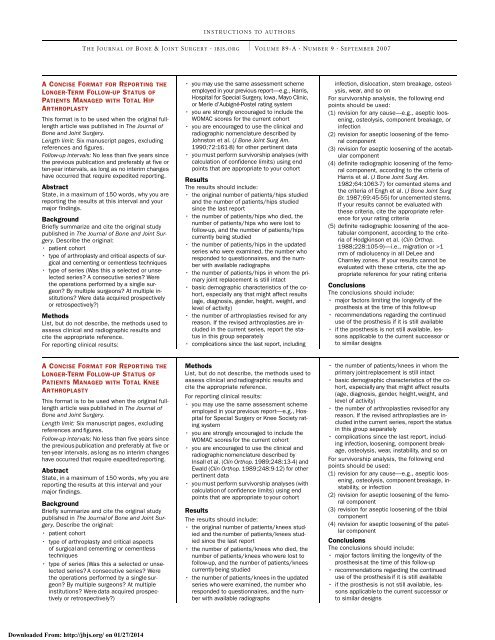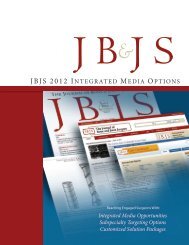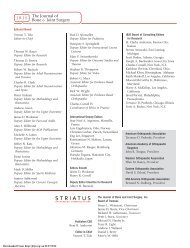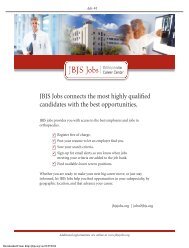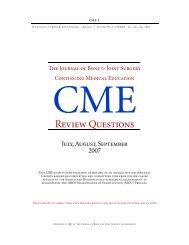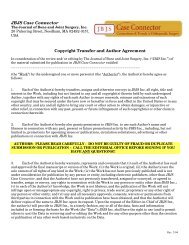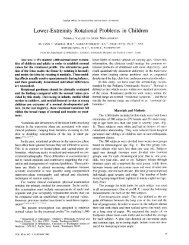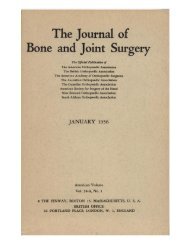Front Matter - The Journal of Bone & Joint Surgery
Front Matter - The Journal of Bone & Joint Surgery
Front Matter - The Journal of Bone & Joint Surgery
Create successful ePaper yourself
Turn your PDF publications into a flip-book with our unique Google optimized e-Paper software.
INSTRUCTIONS TO AUTHORS<br />
THE JOURNAL OF BONE & JOINT SURGERY · JBJS.ORG VOLUME 89-A · NUMBER 9 · SEPTEMBER 2007<br />
A CONCISE FORMAT FOR REPORTING THE<br />
LONGER-TERM FOLLOW-UP STATUS OF<br />
PATIENTS MANAGED WITH TOTAL HIP<br />
ARTHROPLASTY<br />
This format is to be used when the original fulllength<br />
article was published in <strong>The</strong> <strong>Journal</strong> <strong>of</strong><br />
<strong>Bone</strong> and <strong>Joint</strong> <strong>Surgery</strong>.<br />
Length limit: Six manuscript pages, excluding<br />
references and figures.<br />
Follow-up intervals: No less than five years since<br />
the previous publication and preferably at five or<br />
ten-year intervals, as long as no interim changes<br />
have occurred that require expedited reporting.<br />
Abstract<br />
State, in a maximum <strong>of</strong> 150 words, why you are<br />
reporting the results at this interval and your<br />
major findings.<br />
Background<br />
Briefly summarize and cite the original study<br />
published in <strong>The</strong> <strong>Journal</strong> <strong>of</strong> <strong>Bone</strong> and <strong>Joint</strong> <strong>Surgery</strong>.<br />
Describe the original:<br />
• patient cohort<br />
• type <strong>of</strong> arthroplasty and critical aspects <strong>of</strong> surgical<br />
and cementing or cementless techniques<br />
• type <strong>of</strong> series (Was this a selected or unselected<br />
series? A consecutive series? Were<br />
the operations performed by a single surgeon?<br />
By multiple surgeons? At multiple institutions?<br />
Were data acquired prospectively<br />
or retrospectively?)<br />
Methods<br />
List, but do not describe, the methods used to<br />
assess clinical and radiographic results and<br />
cite the appropriate reference.<br />
For reporting clinical results:<br />
• you may use the same assessment scheme<br />
employed in your previous report—e.g., Harris,<br />
Hospital for Special <strong>Surgery</strong>, Iowa, Mayo Clinic,<br />
or Merle d’Aubigné-Postel rating system<br />
• you are strongly encouraged to include the<br />
WOMAC scores for the current cohort<br />
• you are encouraged to use the clinical and<br />
radiographic nomenclature described by<br />
Johnston et al. (J <strong>Bone</strong> <strong>Joint</strong> Surg Am.<br />
1990;72:161-8) for other pertinent data<br />
• you must perform survivorship analyses (with<br />
calculation <strong>of</strong> confidence limits) using end<br />
points that are appropriate to your cohort<br />
Results<br />
<strong>The</strong> results should include:<br />
• the original number <strong>of</strong> patients/hips studied<br />
and the number <strong>of</strong> patients/hips studied<br />
since the last report<br />
• the number <strong>of</strong> patients/hips who died, the<br />
number <strong>of</strong> patients/hips who were lost to<br />
follow-up, and the number <strong>of</strong> patients/hips<br />
currently being studied<br />
• the number <strong>of</strong> patients/hips in the updated<br />
series who were examined, the number who<br />
responded to questionnaires, and the number<br />
with available radiographs<br />
• the number <strong>of</strong> patients/hips in whom the primary<br />
joint replacement is still intact<br />
• basic demographic characteristics <strong>of</strong> the cohort,<br />
especially any that might affect results<br />
(age, diagnosis, gender, height, weight, and<br />
level <strong>of</strong> activity)<br />
• the number <strong>of</strong> arthroplasties revised for any<br />
reason. If the revised arthroplasties are included<br />
in the current series, report the status<br />
in this group separately<br />
• complications since the last report, including<br />
infection, dislocation, stem breakage, osteolysis,<br />
wear, and so on<br />
For survivorship analysis, the following end<br />
points should be used:<br />
(1) revision for any cause—e.g., aseptic loosening,<br />
osteolysis, component breakage, or<br />
infection<br />
(2) revision for aseptic loosening <strong>of</strong> the femoral<br />
component<br />
(3) revision for aseptic loosening <strong>of</strong> the acetabular<br />
component<br />
(4) definite radiographic loosening <strong>of</strong> the femoral<br />
component, according to the criteria <strong>of</strong><br />
Harris et al. (J <strong>Bone</strong> <strong>Joint</strong> Surg Am.<br />
1982;64:1063-7) for cemented stems and<br />
the criteria <strong>of</strong> Engh et al. (J <strong>Bone</strong> <strong>Joint</strong> Surg<br />
Br. 1987;69:45-55) for uncemented stems.<br />
If your results cannot be evaluated with<br />
these criteria, cite the appropriate reference<br />
for your rating criteria<br />
(5) definite radiographic loosening <strong>of</strong> the acetabular<br />
component, according to the criteria<br />
<strong>of</strong> Hodgkinson et al. (Clin Orthop.<br />
1988;228:105-9)—i.e., migration or >1<br />
mm <strong>of</strong> radiolucency in all DeLee and<br />
Charnley zones. If your results cannot be<br />
evaluated with these criteria, cite the appropriate<br />
reference for your rating criteria<br />
Conclusions<br />
<strong>The</strong> conclusions should include:<br />
• major factors limiting the longevity <strong>of</strong> the<br />
prosthesis at the time <strong>of</strong> this follow-up<br />
• recommendations regarding the continued<br />
use <strong>of</strong> the prosthesis if it is still available<br />
• if the prosthesis is not still available, lessons<br />
applicable to the current successor or<br />
to similar designs<br />
A CONCISE FORMAT FOR REPORTING THE<br />
LONGER-TERM FOLLOW-UP STATUS OF<br />
PATIENTS MANAGED WITH TOTAL KNEE<br />
ARTHROPLASTY<br />
This format is to be used when the original fulllength<br />
article was published in <strong>The</strong> <strong>Journal</strong> <strong>of</strong><br />
<strong>Bone</strong> and <strong>Joint</strong> <strong>Surgery</strong>.<br />
Length limit: Six manuscript pages, excluding<br />
references and figures.<br />
Follow-up intervals: No less than five years since<br />
the previous publication and preferably at five or<br />
ten-year intervals, as long as no interim changes<br />
have occurred that require expedited reporting.<br />
Abstract<br />
State, in a maximum <strong>of</strong> 150 words, why you are<br />
reporting the results at this interval and your<br />
major findings.<br />
Background<br />
Briefly summarize and cite the original study<br />
published in <strong>The</strong> <strong>Journal</strong> <strong>of</strong> <strong>Bone</strong> and <strong>Joint</strong> <strong>Surgery</strong>.<br />
Describe the original:<br />
• patient cohort<br />
• type <strong>of</strong> arthroplasty and critical aspects<br />
<strong>of</strong> surgical and cementing or cementless<br />
techniques<br />
• type <strong>of</strong> series (Was this a selected or unselected<br />
series? A consecutive series? Were<br />
the operations performed by a single surgeon?<br />
By multiple surgeons? At multiple<br />
institutions? Were data acquired prospectively<br />
or retrospectively?)<br />
Methods<br />
List, but do not describe, the methods used to<br />
assess clinical and radiographic results and<br />
cite the appropriate reference.<br />
For reporting clinical results:<br />
• you may use the same assessment scheme<br />
employed in your previous report—e.g., Hospital<br />
for Special <strong>Surgery</strong> or Knee Society rating<br />
system<br />
• you are strongly encouraged to include the<br />
WOMAC scores for the current cohort<br />
• you are encouraged to use the clinical and<br />
radiographic nomenclature described by<br />
Insall et al. (Clin Orthop. 1989;248:13-4) and<br />
Ewald (Clin Orthop. 1989;248:9-12) for other<br />
pertinent data<br />
• you must perform survivorship analyses (with<br />
calculation <strong>of</strong> confidence limits) using end<br />
points that are appropriate to your cohort<br />
Results<br />
<strong>The</strong> results should include:<br />
• the original number <strong>of</strong> patients/knees studied<br />
and the number <strong>of</strong> patients/knees studied<br />
since the last report<br />
• the number <strong>of</strong> patients/knees who died, the<br />
number <strong>of</strong> patients/knees who were lost to<br />
follow-up, and the number <strong>of</strong> patients/knees<br />
currently being studied<br />
• the number <strong>of</strong> patients/knees in the updated<br />
series who were examined, the number who<br />
responded to questionnaires, and the number<br />
with available radiographs<br />
• the number <strong>of</strong> patients/knees in whom the<br />
primary joint replacement is still intact<br />
• basic demographic characteristics <strong>of</strong> the cohort,<br />
especially any that might affect results<br />
(age, diagnosis, gender, height, weight, and<br />
level <strong>of</strong> activity)<br />
• the number <strong>of</strong> arthroplasties revised for any<br />
reason. If the revised arthroplasties are included<br />
in the current series, report the status<br />
in this group separately<br />
• complications since the last report, including<br />
infection, loosening, component breakage,<br />
osteolysis, wear, instability, and so on<br />
For survivorship analysis, the following end<br />
points should be used:<br />
(1) revision for any cause—e.g., aseptic loosening,<br />
osteolysis, component breakage, instability,<br />
or infection<br />
(2) revision for aseptic loosening <strong>of</strong> the femoral<br />
component<br />
(3) revision for aseptic loosening <strong>of</strong> the tibial<br />
component<br />
(4) revision for aseptic loosening <strong>of</strong> the patellar<br />
component<br />
Conclusions<br />
<strong>The</strong> conclusions should include:<br />
• major factors limiting the longevity <strong>of</strong> the<br />
prosthesis at the time <strong>of</strong> this follow-up<br />
• recommendations regarding the continued<br />
use <strong>of</strong> the prosthesis if it is still available<br />
• if the prosthesis is not still available, lessons<br />
applicable to the current successor or<br />
to similar designs<br />
Downloaded From: http://jbjs.org/ on 01/27/2014


